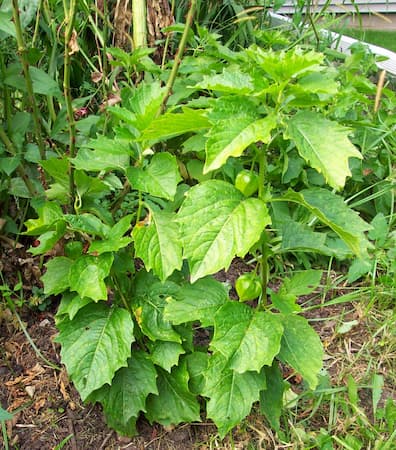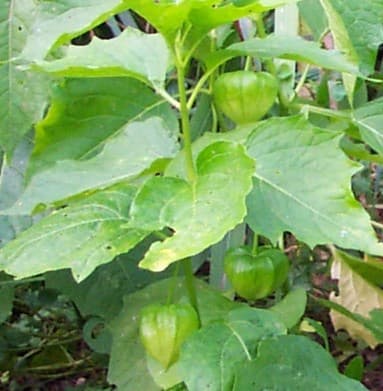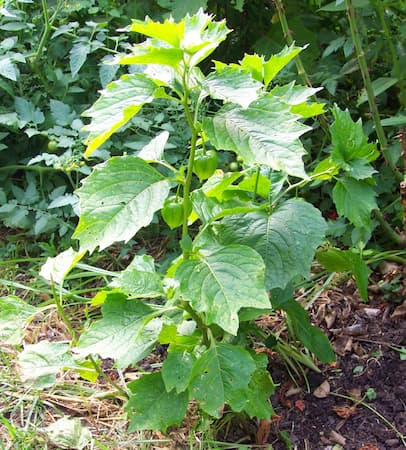How to Grow Chinese Lantern Flowers

Growing Chinese Lanterns in Your Home Flower Garden
Perennial Chinese Lantern flowers are not native to China. Rather, this unique plant originates from southeastern Europe and Japan. Chinese Lantern plants get their name from the distinctive color and shape of the papery husk, which resembles a Chinese (or Japanese) Lantern. Consequently, it is a novel plant and conversation piece. Growing Chinese Lanterns near a walkway, a patio, or a deck where people frequent will cause people to stop and take note. They may even ask you for some seeds or a few rhizomes, too.
Chinese Lantern plants are easy to grow. And, they are somewhat invasive, spreading their rhizomes across the flower garden. We recommend using border edging to contain them. This novel plant grows up to two feet tall. The plant has heart-shaped, blue-green foliage. It produces white, 5-petaled flowers in mid-summer. The flowers give way to a light green, lantern-shaped husk with a berry inside. As it matures, the husk turns a bright orange-red color, and the husk turns papery.
Chinese Lanterns look great in the garden. They grow well in flowerpots on your patio or deck, too. In the fall, dry the colorful lanterns and use them as dried flowers. Dry Chinese Lanterns for indoor arrangements. They are also popular for Fall and Halloween art projects.
IMPORTANT: The unripe berries and the leaves are poisonous. Keep this plant away from children and pets.
Did You Know? Tomatillos and Chinese Lanterns are both grouped as Physalis, members of the nightshade family. Eggplant, peppers, potatoes, and tomatoes are also members of the nightshade family.
Note: Seed companies often classify them as annuals. But, they are a fast-spreading (almost invasive) perennial.
Chinese Lantern Plant Specifications
Flower Colors: The flower is white. The lantern emerging from the flower is orange to reddish-orange.
Flowers Bloom: Mid-summer
Plant Height: One to two feet tall..
Light Requirements: Full sun.
Ideal Soil pH: 6.2 – 7.4.
Hardiness Zone: 3 – 9. This versatile plant grows well in most hardiness zones.
Toxicity: Most parts of this plant are harmful to humans and pets.
Native To: Asia, Southern Europe.
Plant Type: Perennial
Botanical Name: Physalis
Other Names: Ground Cherry, Jerusalem Cherry, Winter Cherry, Husk Tomato, Strawberry Tomato.
Are Chinese Lantern Plants Edible?
YES and NO!!
The plant is not edible. The fruit inside of the colorful seed pod is edible. However, they are not usually consumed as they don’t taste very good.
The plant also has white flowers that produce small berries. These berries are poisonous when unripe.
We recommend you avoid consumption of all parts of this plant.
Medicinal Uses of Chinese Lanterns
As was previously stated, Chinese Lanterns are poisonous. Yet despite the poisonous nature of the leaves and unripe berries, this plant has have had a variety of medicinal applications.
The medicinal applications include anti-inflammatory, expectorant, cough suppressant, fevers, treating malaria, bedwetting, and even promoting early labor!

Light Requirements
For the best performance, grow Chinese Lantern plants in full sun. Grow them in a location where they will receive six to eight hours of full sun. In hotter regions of the country, provide the plants with afternoon sun to protect them from the hot rays of the sun.
Chinese Lantern Perennial Plant Propagation
Achillea is grown from seed. Sow seeds directly seeded into your flower garden or start indoors for transplanting later. For outdoor starts, plant Chinese Lantern seeds 6-8 weeks before the last frost in your area. Then, transplant the young plants into your flower garden after the last frost date for your area.
Outdoors, sow seeds early in the season and cover lightly with soil. Space seeds or seedlings 12-18″ apart.
Once your plants have been established, they can be propagated by division of the rhizomes in the fall.
Chinese Lantern Plant Propagation
New plants are grown from seed. You can start Perennial Chinese Lantern seeds indoors, or out. Because of the long germination period, we recommend an indoor start. Also, we recommend a heated germination mat, for faster, more successful germination.
Space seedlings two to three feet apart.
They will bloom in the first year.
The plants can also be propagated by digging up and dividing the rhizomes. They can be invasive in your flower garden.
Days to Germination: 20-25 days.

How to Grow Perennial Chinese Lantern Flower Plants
Chinese Lantern plants are very easy to grow. They like full sun but will tolerate a partial or light shade.
The plants will do well in average soils. However, the plants are more productive in rich garden soil.
The plants are somewhat invasive. Use border edging to contain their spread in the garden.
Garden Tip: For outdoor plant starts, make sure to mark the planting area, as the seeds take a long time to germinate.
Keep the soil moist, not wet. Allow the soil to dry between watering. Add a general-purpose fertilizer once a month. Apply a thick layer of mulch around the plants to keep weeds down, and to retain soil moisture.
Once your plants are established, they will grow well, with little or no attention, for many years.
After a few years, the plants will begin to get overcrowded. Dig up and separate the rhizomes, leaving at least one eye on each segment. Give a few segments to your friends. They will be appreciative!
After plants have died back in late Fall, cut them back to ground level. Now they are ready to regrow as soon as the rays of the spring sun warms the soil.
How to Prune Chinese Lantern Plants
Like other plants, remove any sick, dead, or diseased leaves and stems.
If you are not saving the spent bloom for craft projects, deadhead spent blooms where the flower stem meets the plant.
More on Deadheading Plants.
How to Dry Chinese Lanterns
Chinese Lanterns are easy to dry. And, the dried lanterns are very long-lasting. They are very popular for use in Fall and Halloween art projects. They also look great in vases to decorate your home.
Cut the stems of the lanterns back as close to the ground as possible. Remove all of the leaves and tie 5-6 lanterns together. Hang them upside down in a cool, dry, and dark location where there is good air circulation. If they are dried where there is light, the color of the lanterns will fade. Let them dry for two to three weeks. Then, the Chinese Lanterns are ready to use for all of your art and decorating projects.
Insects and Plant Disease
A variety of insects like to chew on the leaves of Chinese Lantern plants. Cucumber beetles, flea beetles, and potato beetles ar among the insects that feast on these plants. Use insecticidal soap, neem oil, or general-purpose insecticide as needed.
The plants usually do not have major problems with plant disease. Although mold and fungus can develop in hot and humid weather.
The roots can rot in wet soils. Do not plant in low areas or poorly draining soils.
Also see: Plant Problems – causes and cures.
Please support our site. Shop for:
- rmmatthews100@hotmail.com
- 585-721-6528
- Rochester, NY
©1999-2024 GardenersNet.Com, All Rights Reserved

